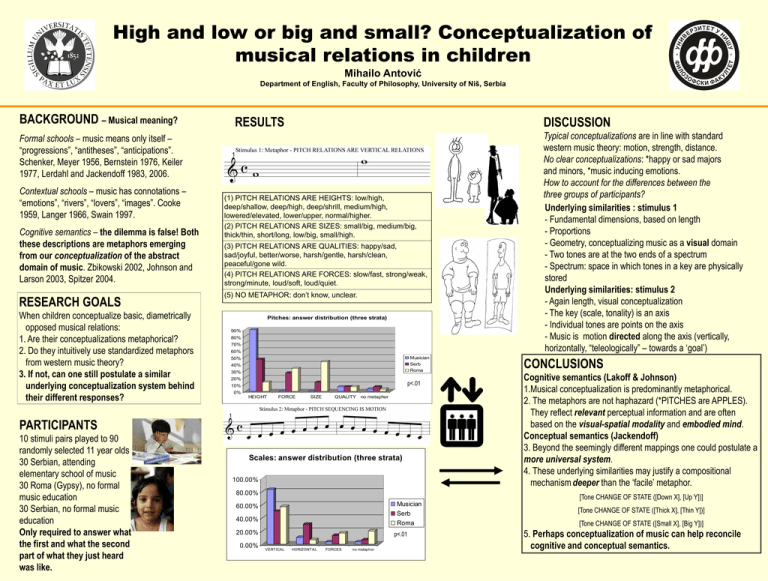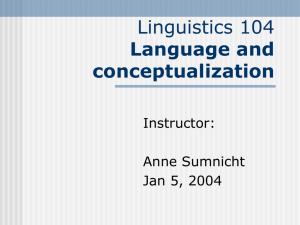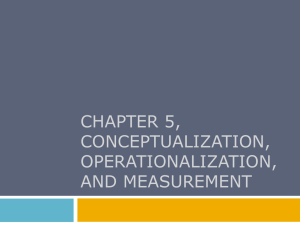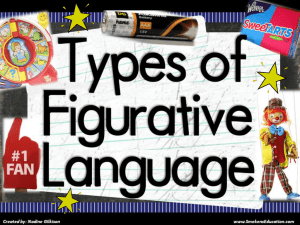DIN A0 Poster Template
advertisement

High and low or big and small? Conceptualization of musical relations in children Mihailo Antović Department of English, Faculty of Philosophy, University of Niš, Serbia BACKGROUND – Musical meaning? RESULTS DISCUSSION Formal schools – music means only itself – “progressions”, “antitheses”, “anticipations”. Schenker, Meyer 1956, Bernstein 1976, Keiler 1977, Lerdahl and Jackendoff 1983, 2006. Contextual schools – music has connotations – “emotions”, “rivers”, “lovers”, “images”. Cooke 1959, Langer 1966, Swain 1997. Cognitive semantics – the dilemma is false! Both these descriptions are metaphors emerging from our conceptualization of the abstract domain of music. Zbikowski 2002, Johnson and Larson 2003, Spitzer 2004. RESEARCH GOALS When children conceptualize basic, diametrically opposed musical relations: 1. Are their conceptualizations metaphorical? 2. Do they intuitively use standardized metaphors from western music theory? 3. If not, can one still postulate a similar underlying conceptualization system behind their different responses? (1) PITCH RELATIONS ARE HEIGHTS: low/high, deep/shallow, deep/high, deep/shrill, medium/high, lowered/elevated, lower/upper, normal/higher. (2) PITCH RELATIONS ARE SIZES: small/big, medium/big, thick/thin, short/long, low/big, small/high. (3) PITCH RELATIONS ARE QUALITIES: happy/sad, sad/joyful, better/worse, harsh/gentle, harsh/clean, peaceful/gone wild. (4) PITCH RELATIONS ARE FORCES: slow/fast, strong/weak, strong/minute, loud/soft, loud/quiet. (5) NO METAPHOR: don’t know, unclear. Pitches: answer distribution (three strata) 90% 80% 70% 60% Musician Serb Roma 50% 40% 30% 20% p<.01 10% 0% HEIGHT FORCE SIZE QUALITY no metaphor PARTICIPANTS 10 stimuli pairs played to 90 randomly selected 11 year olds 30 Serbian, attending elementary school of music 30 Roma (Gypsy), no formal music education 30 Serbian, no formal music education Only required to answer what the first and what the second part of what they just heard was like. Scales: answer distribution (three strata) 100.00% 80.00% CONCLUSIONS Cognitive semantics (Lakoff & Johnson) 1.Musical conceptualization is predominantly metaphorical. 2. The metaphors are not haphazard (*PITCHES are APPLES). They reflect relevant perceptual information and are often based on the visual-spatial modality and embodied mind. Conceptual semantics (Jackendoff) 3. Beyond the seemingly different mappings one could postulate a more universal system. 4. These underlying similarities may justify a compositional mechanism deeper than the ‘facile’ metaphor. [Tone CHANGE OF STATE ([Down X], [Up Y])] Musician Serb Roma 60.00% 40.00% 20.00% 0.00% Typical conceptualizations are in line with standard western music theory: motion, strength, distance. No clear conceptualizations: *happy or sad majors and minors, *music inducing emotions. How to account for the differences between the three groups of participants? Underlying similarities : stimulus 1 - Fundamental dimensions, based on length - Proportions - Geometry, conceptualizing music as a visual domain - Two tones are at the two ends of a spectrum - Spectrum: space in which tones in a key are physically stored Underlying similarities: stimulus 2 - Again length, visual conceptualization - The key (scale, tonality) is an axis - Individual tones are points on the axis - Music is motion directed along the axis (vertically, horizontally, “teleologically” – towards a ‘goal’) p<.01 VERT ICAL HORIZONT AL FORCES no metaphor [Tone CHANGE OF STATE ([Thick X], [Thin Y])] [Tone CHANGE OF STATE ([Small X], [Big Y])] 5. Perhaps conceptualization of music can help reconcile cognitive and conceptual semantics.











